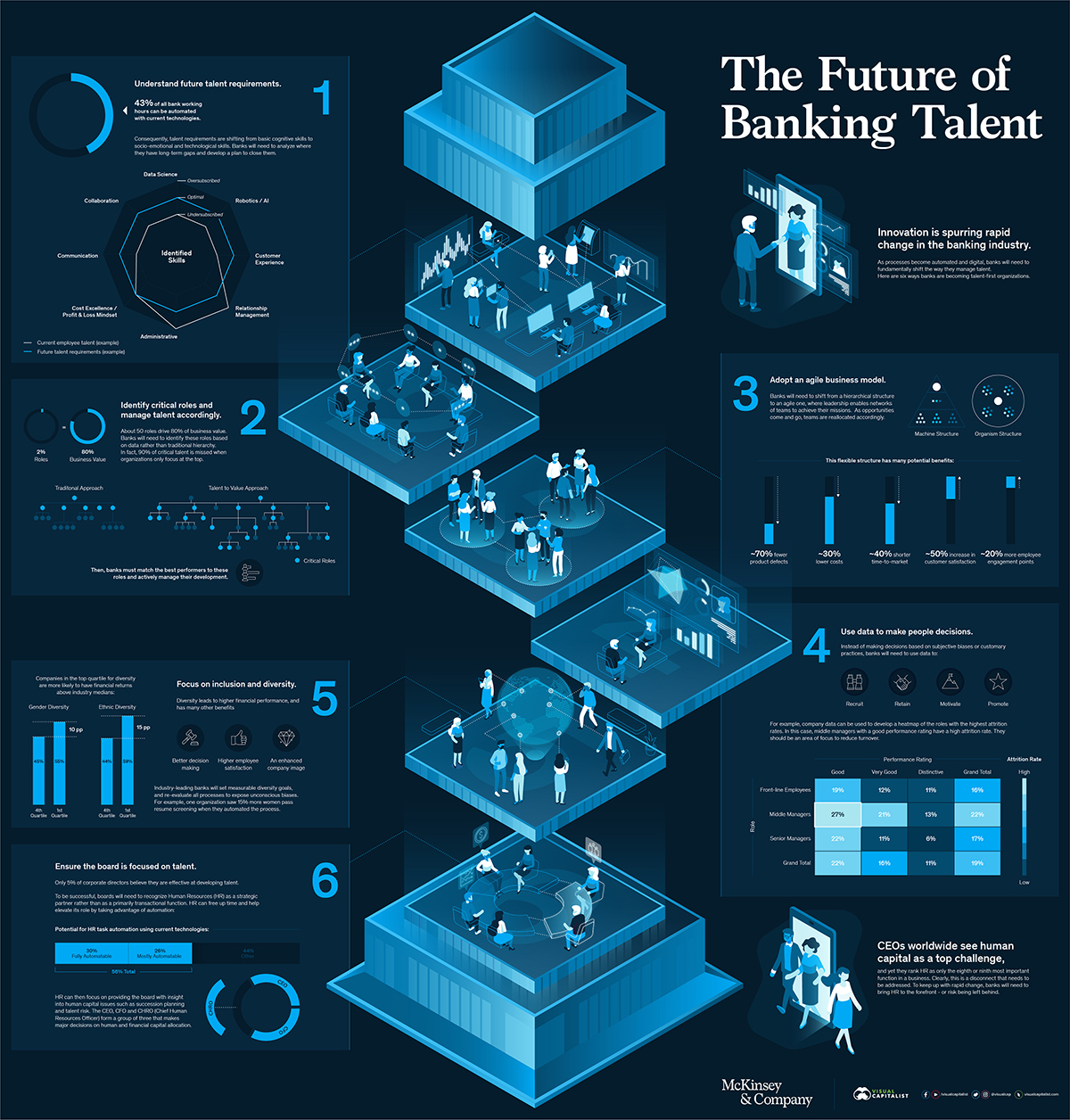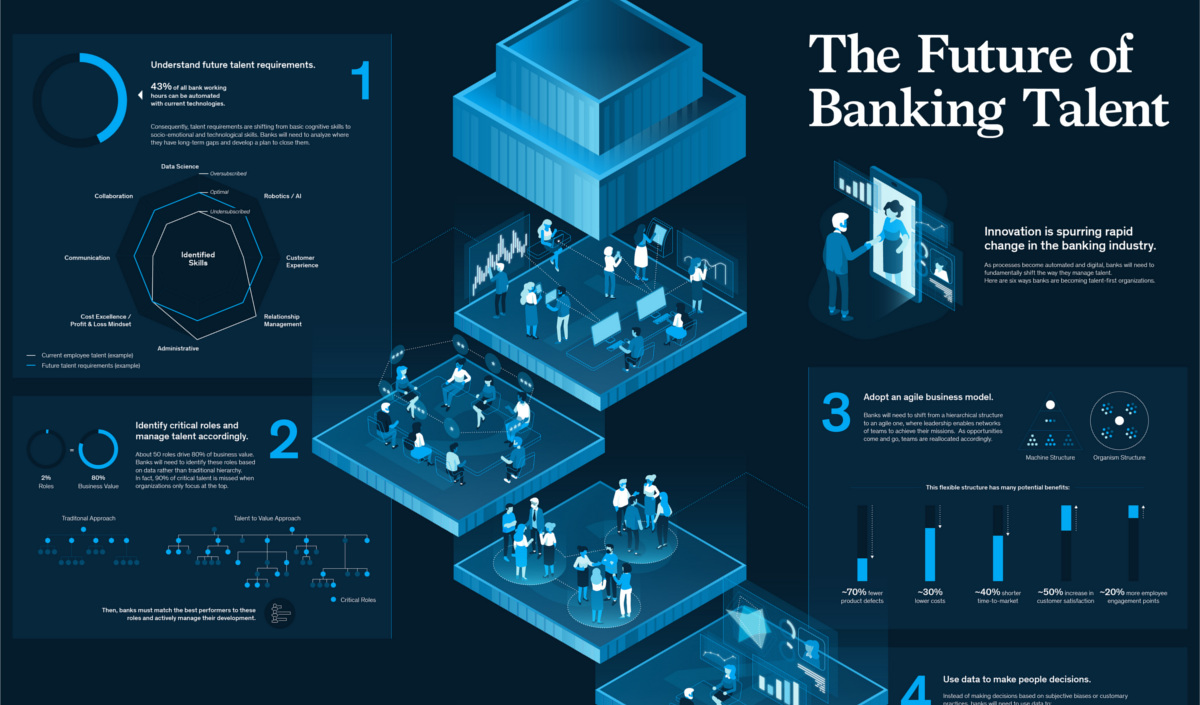Technology
Visualizing the Future of Banking Talent
View a high resolution version of this graphic
Visualizing the Future of Banking Talent
View the full-size version of the infographic by clicking here
Many organizations say that their greatest asset is their people. In fact, Richard Branson has famously stated that employees come first at Virgin, ranking ahead of customers and shareholders. So, how do businesses effectively manage this talent to drive success?
This question is top of mind for many bank CEOs. As processes become increasingly automated and digitized, the composition of banking talent is changing – and banks will need to become adept at hitting a moving target.
Six Ways Banks are Becoming Talent-First
Today’s infographic comes from McKinsey & Company, and it explores six ways banks are becoming talent-first organizations:
1. They understand future talent requirements.
43% of all bank working hours can be automated with current technologies.
Consequently, talent requirements are shifting from basic cognitive skills to socio-emotional and technological skills. Banks will need to analyze where they have long-term gaps and develop a plan to close them.
2. They identify critical roles and manage talent accordingly.
It is estimated that just 50 key roles drive 80% of bank business value. Banks will need to identify these roles based on data rather than traditional hierarchy. In fact, 90% of critical talent is missed when organizations only focus at the top.
Then, banks must match the best performers to these roles and actively manage their development.
3. They adopt an agile business model.
Banks will need to shift from a hierarchical structure to an agile one, where leadership enables networks of teams to achieve their missions. As opportunities come and go, teams are reallocated accordingly.
This flexible structure has many potential benefits, including fewer product defects, lower costs, shorter time-to-market, increases in customer satisfaction, and a bump in employee engagement.
4. They use data to make people decisions.
Instead of making decisions based on subjective biases or customary practices, banks will need to rely on the power of data to:
- Recruit
- Retain
- Motivate
- Promote
For example, company data can be used to develop a heatmap of the roles with the highest attrition rates. Leaders can then focus their retention efforts accordingly.
5. They focus on inclusion and diversity.
Gender and ethnicity diversification leads to higher financial performance, better decision making, higher employee satisfaction, and an enhanced company image.
Industry-leading banks will set measurable diversity goals, and re-evaluate all processes to expose unconscious biases. For example, one organization saw 15% more women pass resume screening when they automated the process.
6. They ensure the board is focused on talent.
Only 5% of corporate directors believe they are effective at developing talent.
To be successful, boards will need to recognize Human Resources (HR) as a strategic partner rather than as a primarily transactional function. The CEO, CFO, and CHRO (Chief Human Resources Officer) form a group of three that makes major decisions on human and financial capital allocation.
CEOs worldwide see human capital as a top challenge, and yet they rank HR as only the eighth or ninth most important function in a business. Clearly, this is a disconnect that needs to be addressed. To keep up with rapid change, banks will need to bring HR to the forefront – or risk being left behind.
Technology
Visualizing AI Patents by Country
See which countries have been granted the most AI patents each year, from 2012 to 2022.

Visualizing AI Patents by Country
This was originally posted on our Voronoi app. Download the app for free on iOS or Android and discover incredible data-driven charts from a variety of trusted sources.
This infographic shows the number of AI-related patents granted each year from 2010 to 2022 (latest data available). These figures come from the Center for Security and Emerging Technology (CSET), accessed via Stanford University’s 2024 AI Index Report.
From this data, we can see that China first overtook the U.S. in 2013. Since then, the country has seen enormous growth in the number of AI patents granted each year.
| Year | China | EU and UK | U.S. | RoW | Global Total |
|---|---|---|---|---|---|
| 2010 | 307 | 137 | 984 | 571 | 1,999 |
| 2011 | 516 | 129 | 980 | 581 | 2,206 |
| 2012 | 926 | 112 | 950 | 660 | 2,648 |
| 2013 | 1,035 | 91 | 970 | 627 | 2,723 |
| 2014 | 1,278 | 97 | 1,078 | 667 | 3,120 |
| 2015 | 1,721 | 110 | 1,135 | 539 | 3,505 |
| 2016 | 1,621 | 128 | 1,298 | 714 | 3,761 |
| 2017 | 2,428 | 144 | 1,489 | 1,075 | 5,136 |
| 2018 | 4,741 | 155 | 1,674 | 1,574 | 8,144 |
| 2019 | 9,530 | 322 | 3,211 | 2,720 | 15,783 |
| 2020 | 13,071 | 406 | 5,441 | 4,455 | 23,373 |
| 2021 | 21,907 | 623 | 8,219 | 7,519 | 38,268 |
| 2022 | 35,315 | 1,173 | 12,077 | 13,699 | 62,264 |
In 2022, China was granted more patents than every other country combined.
While this suggests that the country is very active in researching the field of artificial intelligence, it doesn’t necessarily mean that China is the farthest in terms of capability.
Key Facts About AI Patents
According to CSET, AI patents relate to mathematical relationships and algorithms, which are considered abstract ideas under patent law. They can also have different meaning, depending on where they are filed.
In the U.S., AI patenting is concentrated amongst large companies including IBM, Microsoft, and Google. On the other hand, AI patenting in China is more distributed across government organizations, universities, and tech firms (e.g. Tencent).
In terms of focus area, China’s patents are typically related to computer vision, a field of AI that enables computers and systems to interpret visual data and inputs. Meanwhile America’s efforts are more evenly distributed across research fields.
Learn More About AI From Visual Capitalist
If you want to see more data visualizations on artificial intelligence, check out this graphic that shows which job departments will be impacted by AI the most.
-

 Mining1 week ago
Mining1 week agoGold vs. S&P 500: Which Has Grown More Over Five Years?
-

 Markets2 weeks ago
Markets2 weeks agoRanked: The Most Valuable Housing Markets in America
-

 Money2 weeks ago
Money2 weeks agoWhich States Have the Highest Minimum Wage in America?
-

 AI2 weeks ago
AI2 weeks agoRanked: Semiconductor Companies by Industry Revenue Share
-

 Markets2 weeks ago
Markets2 weeks agoRanked: The World’s Top Flight Routes, by Revenue
-

 Countries2 weeks ago
Countries2 weeks agoPopulation Projections: The World’s 6 Largest Countries in 2075
-

 Markets2 weeks ago
Markets2 weeks agoThe Top 10 States by Real GDP Growth in 2023
-

 Demographics2 weeks ago
Demographics2 weeks agoThe Smallest Gender Wage Gaps in OECD Countries



